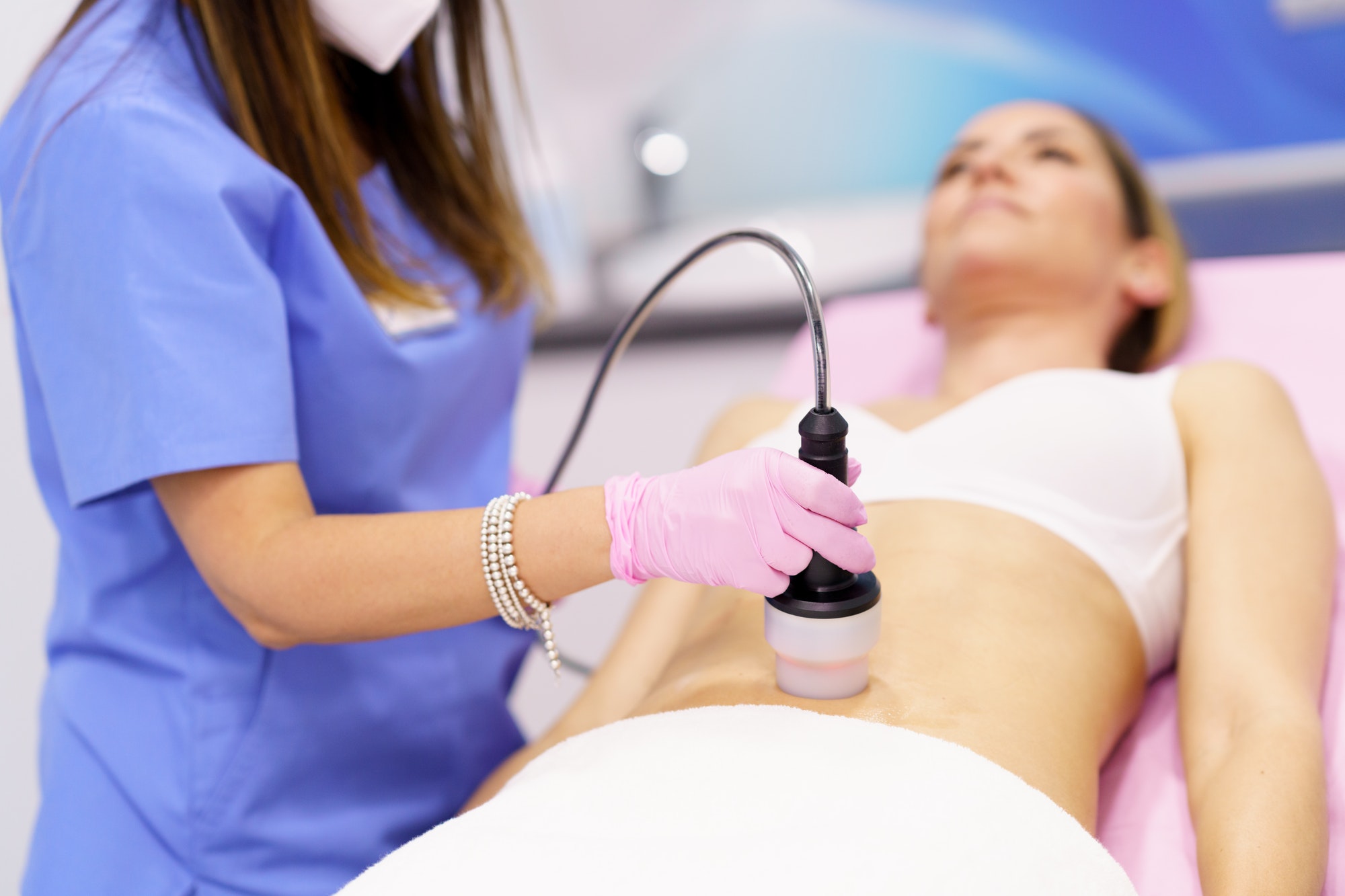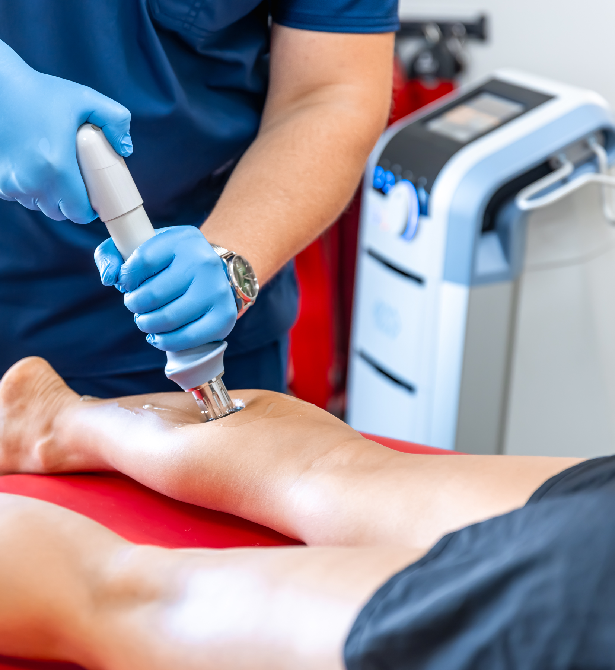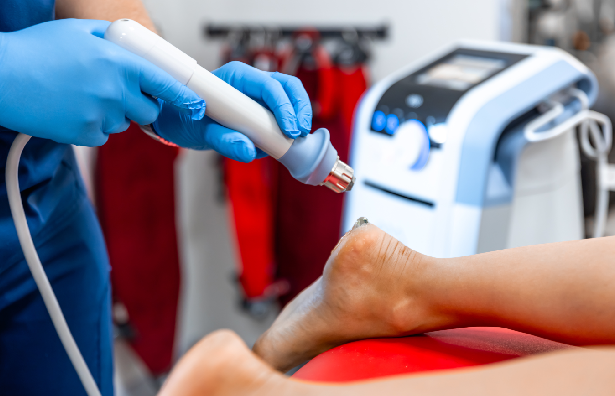Shockwave Therapy
- Home
- Shockwave Therapy
Revitalife
A Game-Changer in Pain Relief & Recovery

Shockwave Therapy
Shockwave therapy revolutionizes musculoskeletal care through non-invasive acoustic waves that stimulate natural healing. This advanced treatment accelerates tissue repair, reduces pain, and restores function without surgery. Effective for tendon injuries and chronic conditions, it activates cellular regeneration through targeted mechanical energy, offering athletes and patients faster recovery with minimal downtime.
Types of Shockwave Therapy
-
Focused Shockwave Therapy (FSWT) uses precisely targeted acoustic waves to penetrate deep into affected tissues. This concentrated approach makes it ideal for treating conditions requiring deep-tissue intervention.
- Radial Shockwave Therapy (RSWT) employs a diffused wave pattern to treat surface-level injuries. Particularly effective for plantar fasciitis and muscle stiffness, this gentler approach enhances blood flow, dissolves scar tissue, and reduces inflammation. As a non-invasive treatment, RSWT stimulates natural healing through targeted sound wave energy.
Applications
-
Diabetic Foot Ulcers (DFUs): RSWT stimulates improved circulation to the wound area, facilitating quicker healing while reducing inflammation and promoting tissue repair.
- Cellulite Treatment: RSWT effectively targets cellulite by disrupting fat deposits while stimulating collagen synthesis. This dual-action approach smoothes skin texture, enhances microcirculation, and promotes lymphatic drainage, delivering visibly firmer, more toned skin with improved contour.
-
Sexual Wellness: RSWT offers a breakthrough solution for sexual dysfunction by enhancing penile blood flow and tissue regeneration in men, effectively addressing erectile dysfunction (ED). For women, it provides a pain-free, zero-downtime treatment for female sexual dysfunction (FSD) while also improving urinary incontinence when combined with targeted Kegel exercises.
Science of Shockwave Therapy
How Shockwave Therapy Works: This innovative treatment delivers precisely calibrated acoustic waves that create controlled microtrauma at the cellular level. These high-energy pulses stimulate the body’s innate repair mechanisms, triggering:
-
Acoustic Wave Action: Shockwaves penetrate tissues, creating micro-cavitation bubbles that implode, generating therapeutic effects:
- Boost cell activity
- Break up scar tissue
- Stimulate new blood vessels
- Improve local circulation
-
Pain Relief: Shockwaves trigger natural endorphins while blocking pain signals, providing fast, drug-free relief and accelerating healing.
-
Tissue Regeneration: Shockwaves activate collagen-producing fibroblasts, repairing damaged tissues while improving strength and flexibility.
-
Enhanced Circulation: Shockwave therapy boosts blood flow to injured areas, delivering healing nutrients and oxygen while removing waste. This speeds recovery and reduces inflammation naturally.
-
Scar Tissue Removal: Shockwaves break down tough scar tissue while activating the body's natural cleanup system to clear debris and promote healing.

Practical Example
After traditional treatments like rest, NSAIDs, and physical therapy failed, a marathon runner with persistent Achilles tendinopathy achieved recovery through shockwave therapy. The treatment activated the tendon’s healing response, enhanced circulation, and stimulated collagen regeneration – ultimately restoring pain-free function and enabling a return to running.
Historical Development of Shockwave Therapy
First developed in the 1800s for kidney stone treatment (lithotripsy), shockwave therapy uses focused waves to fragment stones. Its application for soft tissue healing remained unexplored until the 1990s, when researchers discovered its effectiveness for stubborn musculoskeletal conditions like chronic tendinitis and calcific tendonitis. These findings transformed it into a mainstream rehabilitation tool for treatment-resistant cases.

Latest Research
Recent research confirms shockwave therapy’s efficacy for plantar fasciitis, Achilles tendinopathy, and jumper’s knee. A 2021 Journal of Orthopedic Research study (PMC) found that combining shockwave treatment with physical therapy accelerates recovery and enhances functional outcomes in chronic tendon disorders compared to conventional approaches alone.
Mechanisms of Action
Shockwave therapy’s therapeutic power stems from fundamental acoustic physics. The technology delivers precisely controlled energy pulses that produce three key biological effects:
- Micro-Trauma Stimulation: Shockwaves induce controlled tissue micro-damage, activating the body's healing cascade. This localized inflammatory response releases growth factors and stimulates collagen synthesis, which are essential components for effective tissue regeneration.
-
Collagen Synthesis: Shockwave therapy activates fibroblasts—the primary collagen-producing cells—enhancing structural protein formation. This strengthens damaged tendons and ligaments by promoting organized, functional collagen fiber regeneration.
-
Enhanced Circulation: Shockwave therapy stimulates vasodilation, significantly increasing oxygen-rich blood flow to injured tissues. This optimized nutrient delivery and waste removal accelerates healing while naturally reducing pain.
- Pain Relief: Shockwave therapy reduces pain by activating natural endorphin release and modulating pain signals. This makes it especially valuable for chronic, treatment-resistant conditions where conventional treatments have failed.
Mechanism of Action: ESWT converts chronic pain signals into acute inflammatory responses, triggering the body’s natural healing cascade. When combined with regenerative therapies like Exosomes or PRP, this synergistic approach enhances tissue repair and accelerates recovery.
Patient Success Story
A competitive runner with persistent hip pain underwent shockwave therapy. The treatment penetrated deep into affected tissues, stimulating cellular regeneration and blood flow. Within weeks, they reported significantly reduced discomfort and restored range of motion, allowing a full return to training.
Key Therapeutic Advantages
Shockwave therapy delivers clinically-proven benefits for various musculoskeletal conditions:
- Plantar Fasciitis: Breaks down scar tissue while stimulating collagen regeneration, providing lasting relief from heel pain and restoring normal gait.
- Tendon Repair: Effectively treats chronic tendinopathies (Achilles, rotator cuff) by activating tendon stem cells and promoting structured collagen realignment.
- Soft Tissue Recovery: Accelerates healing in muscle and ligament injuries by enhancing microcirculation and reducing inflammatory markers.
- Chronic Pain Management: Offers a breakthrough solution for treatment-resistant cases by resetting pain pathways and promoting tissue regeneration.
Clinical Case Study
A construction worker with calcific shoulder tendinitis experienced 80% pain reduction after five shockwave sessions. Follow-up imaging showed decreased calcifications and improved tissue integrity, enabling return to complete work duties.
Treatment Modality Comparison
- vs. Ultrasound Therapy: While ultrasound benefits superficial inflammation, shockwaves have higher energy penetration (up to 6cm), making them superior for chronic deep-tissue pathologies.
- vs. Laser Therapy: Both reduce inflammation, but shockwave demonstrates superior long-term outcomes for tendinopathies due to its mechanotransduction effects on cellular repair.
Equipment Selection Guide
- Precision Controls: Look for 0.01mJ/mm² energy increments for optimal dosing
- Modular Applicators: 15-20mm treatment heads accommodate different anatomical regions
- Smart Interfaces: Touchscreen systems with preset protocols streamline clinical workflows
- Depth Verification: Advanced models feature real-time tissue penetration monitoring
- Outcome Tracking: Integrated software for documenting treatment progress and results
Case studies
Clinical Evidence: ESWT vs Traditional Therapy
Study: Randomized Controlled Trial of Shockwave Therapy for Chronic Plantar Fasciitis (2023)
Key Outcomes
This comparative study evaluated ESWT against corticosteroid injections with ultrasound therapy in female patients with persistent plantar fasciitis (6+ months duration). The shockwave therapy group demonstrated:
- Significantly greater pain reduction (VAS scores improved by 78% vs 52%)
- Superior functional improvement (FFI scores increased by 65% vs 42%)
- Longer-lasting therapeutic effects at 6-month follow-up
Evidence-Based Results
Study: Placebo-Controlled Trial of ESWT for Plantar Fasciitis (2020)
Clinical Outcomes
This gold-standard randomized trial compared active ESWT with placebo treatment in chronic plantar fasciitis patients:
- 73% pain reduction in ESWT group vs 28% in placebo (VAS scale)
- 2.5x greater functional improvement (measured by AOFAS scores)
- Durable therapeutic effects maintained at 6-month evaluation
- 78% patient satisfaction rate with ESWT treatment
Clinical Application
Condition: Carpal Tunnel Syndrome Management
Therapeutic Outcomes
A 42-year-old office worker with moderate carpal tunnel syndrome (confirmed by EMG) received shockwave therapy as part of a multimodal rehabilitation program:
- 65% reduction in nighttime paraesthesia after four sessions
- Improved grip strength from 18kg to 26kg (Jamar dynamometer)
- Boston CTS Questionnaire score improved by 58%
- Able to resume complete computer work without splints
Clinical data from NYDNRehab.com case archives

